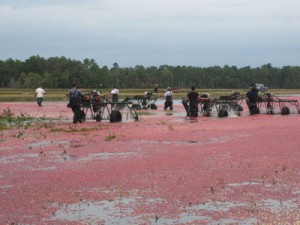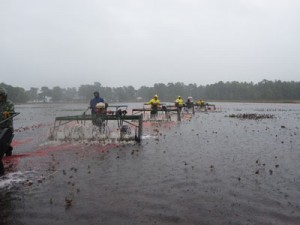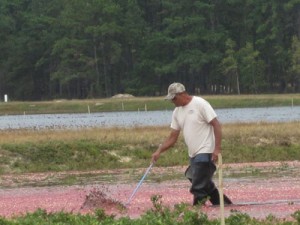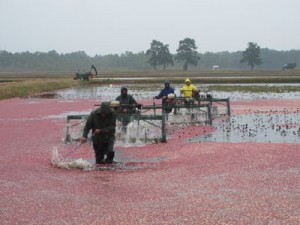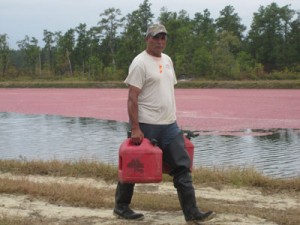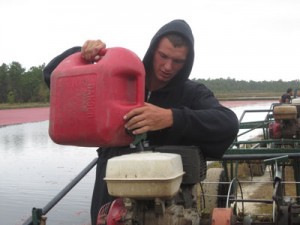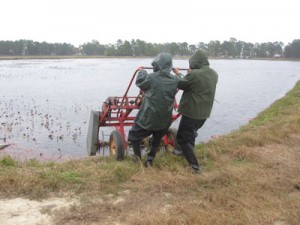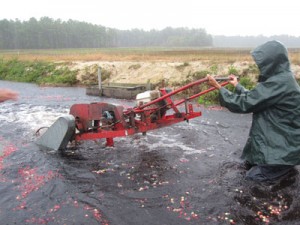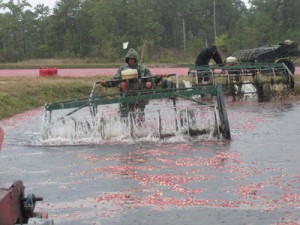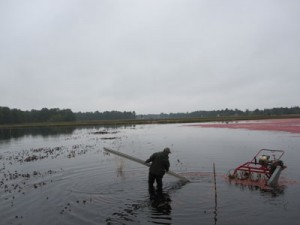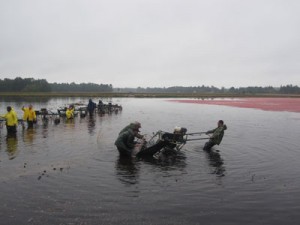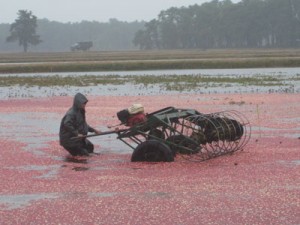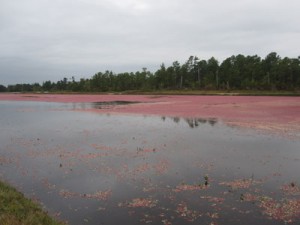Everyone is familiar with the sight of cranberry bogs in the fall; people remain fascinated by the spectacle. It is always one of the most poetic descriptions in a newspaper or blog story. But the reality is much more complex; running a picking crew is a carefully choreographed dance that requires both strength and skill to manage.
Rick Zapata, our Green Team crew leader, has been running a picking crew for years. “There’s a lot to think about,” he says. “It’s not as easy as just putting the machines in the water.” There’s a method to it in order to keep from damaging the fruit or the vines. The difficulty fluctuates slightly due to bog size, weeds, and terrain, as well as other variables such as water levels, crop size, and even berry variety, as newer varieties typically have a greater yield. Rick also points out that some berries do not float to the surface as easily and remain under the vine canopy, which is why they stagger machines in the water in order to both maximize yield and minimize damage to the vines.
Each bog is picked in a specific pattern according to terrain, and the picking crew has to carefully move their harvesters around stakes which have been arranged by the team leader for maximum operational efficiency. Following this pattern allows for minimal damage to the vines. Rick also needs to stay ahead of his crew and check for ditches, for everyone’s safety. “It’s easier on newer bogs; they’re more uniform,” he says. “But after a while you get to know your own section and you understand how it goes.”
The picking crew leaders are also tasked with making sure the machines have enough fuel. The machines usually hold enough fuel for about four hours of picking, so the crew leader needs to make sure that their crew has an adequate supply to maintain their harvesters.
The basic process actually is fairly simple: water reels, or “beaters” are used to stir up the water in the bogs. The berries are dislodged, or “knocked”, from the vines and float to the surface of the water. The machines are slowly rolled into the water and the wheels are lined up against each other, but not in a straight line. Initially, Rick will walk the bog ahead of the edge harvester, which is smaller and lighter than the other harvesting machines in order to maneuver more easily near the ditches. In this particular bog (Champion B, a 6.5 acre bog planted with Early Blacks), the bog is divided into sections outlined by the irrigation ditches, and the picking crew will complete picking each section before they move on to the next.
Teamwork is important while in the middle of the bog. Rick has been working with the same picking team for about three or four years, and they all know what they need to do when they need to do it. “If I have to get out of the bog for any reason at all, I can trust any one of them to take the lead until I get back,” Rick says. For instance, he turned the reins over to Jose Hernandez-Vargas, asking him to lead the crew around the section while he stepped out to remove the ramps from the entry point and bring them over to the unpicked section to make it easier to cross the ditch. The crew didn’t miss a beat!
Our team works in all kinds of weather, rain or shine. The only thing to get them out of the water is lightning. And if the picking crew gets ahead of the gathering crew, they’ll take care of some of the odd jobs such as staking, removing sprinklers, or cleaning out the leaves from finished bogs…as always, doing whatever it takes to make Pine Island Cranberry the best at what we do!

